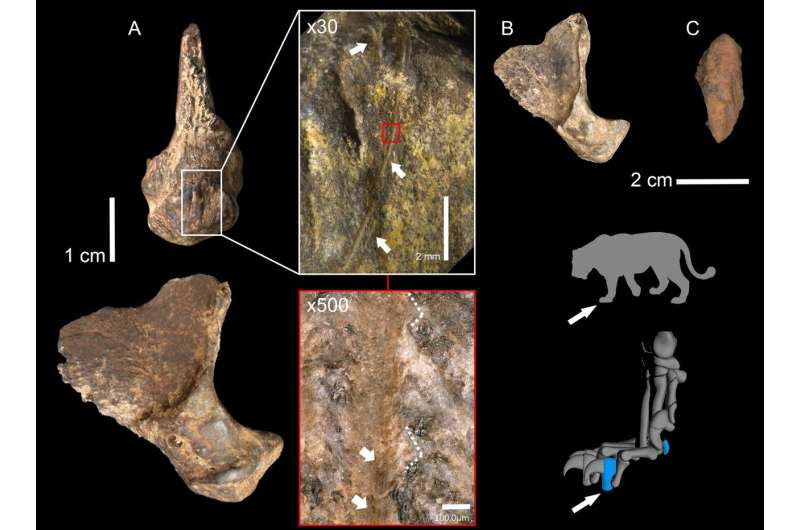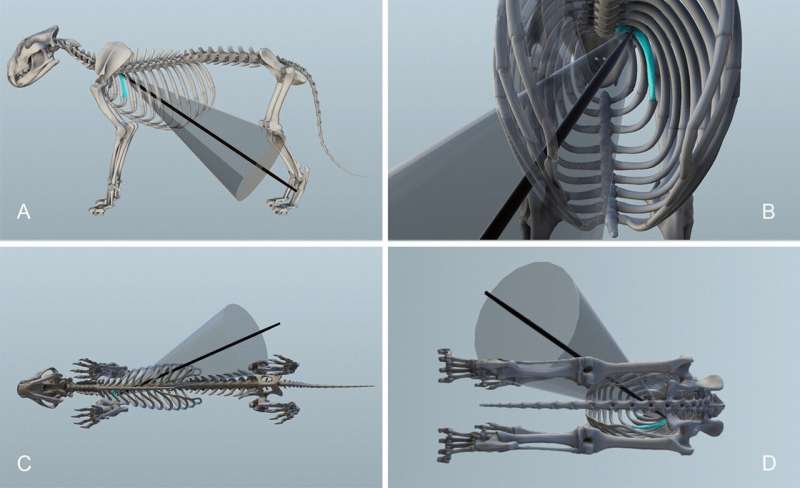This article has been reviewed according to Science X's editorial process and policies. Editors have highlighted the following attributes while ensuring the content's credibility:
fact-checked
peer-reviewed publication
trusted source
proofread
Neanderthals hunted dangerous cave lions, study shows

Neanderthals hunted cave lions and used the skin of this dangerous carnivore, a new study has shown for the first time.
Excavations at Einhornhöhle (Unicorn Cave) in the Harz Mountains (Lower Saxony, Germany) in 2019 uncovered abundant Ice Age animals, among which were a few bones of the extinct cave lion. The bones were discovered in a cave gallery approximately 30 meters from the now-collapsed entrance in a layer that dates to more than 200,000 years ago.
The new study, published in the journal Scientific Reports, outlines how a research team detected a toe bone with a cut mark among the remains of the cave lion. This led to the team determining that Neanderthals removed the lion's pelt with the claws attached, indicating that they used the skin for their own purposes.
But the bones found at Einhornhöhle did not provide any direct evidence for hunting. In order to contextualize the finding, lead author Gabriele Russo, of Universität Tübingen in Germany, analyzed the remains of a cave lion found by a teenager from Siegsdorf in Bavaria. A closer inspection by Russo of the skeleton led to the detection of some unusual damage on a rib. Working together with archaeologist Dr. Annemieke Milks, of the University of Reading, the damage was identified as a weapon impact.
Russo said, "The rib lesion clearly differs from bite marks of carnivores and shows the typical breakage pattern of a lesion caused by a hunting weapon."
Dr. Milks said, "The lion was probably killed by a spear that was thrust into the lion's abdomen when it was already lying on the ground."
The 50,000-year-old skeleton has helped researchers to show for the first time that Neanderthals hunted cave lions. The cut marks also show that not only did they kill this apex predator, they also consumed its meat.

Top predator
The cave lion had a shoulder height of around 1.3 meters. For about 200,000 years the cave lion was the most dangerous animal in Eurasia, until it went extinct at the end of the Ice Age. Cave lions lived in various environments from the steppe to the mountains and as a top predator hunted large herbivores such as mammoth, bison and horse, as well as cave bear. The regular presence of cave lion bones in Ice Age caves is responsible for the name.
Until today, engagement on a cultural level with that top predator was thought to be absent before the time of Homo sapiens. Among Homo sapiens' earliest artworks are those known from caves of the Swabian Jura in Southwest-Germany. There, the cave lion is a prominent motif, exemplified by the famous lion man made of ivory dated to around 40,000 years ago.
Cave lions also feature in rock art panels in Grotte Chauvet in south-eastern France, which are about 34,000 years old.
The new results demonstrate that cave lions also held special meaning for Neanderthals. Thomas Terberger, speaker of the project, says, "The interest of humans to gain respect and power from a lion trophy is rooted in Neanderthal behavior and until modern times the lion is a powerful symbol of rulers."
The new study contributes to the growing picture of behavioral similarities between Neanderthals and early Homo sapiens. Recently, an engraved giant deer bone from Einhornhöhle showed the ability of Neanderthals to produce and communicate with symbols. The role of cave lions fits with the evidence of more complex Neanderthal behaviors, and could even have laid the basis for later cultural developments by Homo sapiens.
More information: Gabriele Russo, First direct evidence of lion hunting and the early use of a lion pelt by Neanderthals, Scientific Reports (2023). DOI: 10.1038/s41598-023-42764-0. www.nature.com/articles/s41598-023-42764-0
Journal information: Scientific Reports
Provided by University of Reading




















